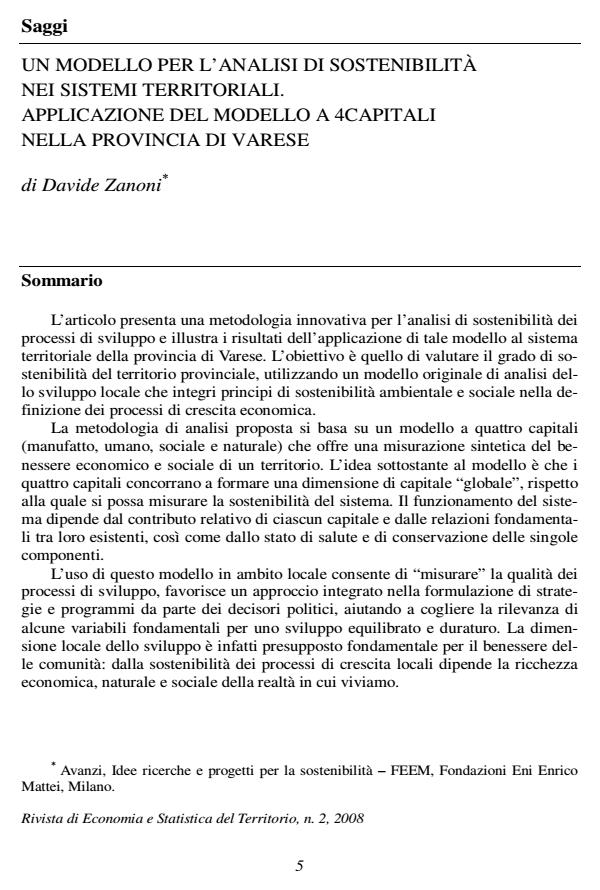Un modello per l'analisi di sostenibilità nei sistemi territoriali. Applicazione del modello a 4Capitali nella provincia di Varese
Titolo Rivista RIVISTA DI ECONOMIA E STATISTICA DEL TERRITORIO
Autori/Curatori Davide Zanoni
Anno di pubblicazione 2008 Fascicolo 2008/2
Lingua Italiano Numero pagine 39 P. 5-43 Dimensione file 248 KB
DOI
Il DOI è il codice a barre della proprietà intellettuale: per saperne di più
clicca qui
Qui sotto puoi vedere in anteprima la prima pagina di questo articolo.
Se questo articolo ti interessa, lo puoi acquistare (e scaricare in formato pdf) seguendo le facili indicazioni per acquistare il download credit. Acquista Download Credits per scaricare questo Articolo in formato PDF

FrancoAngeli è membro della Publishers International Linking Association, Inc (PILA)associazione indipendente e non profit per facilitare (attraverso i servizi tecnologici implementati da CrossRef.org) l’accesso degli studiosi ai contenuti digitali nelle pubblicazioni professionali e scientifiche
A model for sustainability assessment at the local level: the case of Varese Objectives This paper illustrates an innovative methodological approach to carry out sustainability assessment at the local level and presents results from the application of the model to the Province of Varese (Italy). The general aim of the project is to assist in integrating sustainable development (SD) objectives into local policy objectives, through an innovative approach for the evaluation of local systems. More specific objectives are to identify ways to generate better strategies and projects promoting SD and to provide a tool which can assist local authorities in assessing the sustainability of their territorial systems. Methods and Results For the purposes of this study, the operational definition of sustainable development is the provision of services and benefits that increase human well-being without causing a decline in capital stocks. Types of capital that sustain well-being, because of their levels and distribution, include man-made, natural, human and social capital. A key issue for SD is the extent to which different types of capital can be substituted for each other. When substitution at the margin is possible, depletion of one type of capital is consistent with sustainability if it can be offset by an increase in other types. However, different types of capital are not always substitutable. For example, in the presence of critical thresholds for some resources, the cost of further degradation may escalate rapidly, calling for policies that maintain the quality and resilience of these resources. The application of the model to a local system, such as the province of Varese, made a contribution to assessing to what degree different types of capital are truly substitutable. The tool could be used by local authorities to assess the quality of local development and to learn how to measure each kind of capital, how to define an exchange rate between them, describing the acceptable trade-offs. Conclusions This approach raises three issues for measuring sustainable development: -?the most socially desirable combination of the different types of capital in the total stock of capital, i. e. the stock that maximises social welfare now and in the future; ?the critical or minimum thresholds of each type of capital below which substitution is unacceptable; and the spatial and temporal boundaries within which measurement is defined.�;
Davide Zanoni, Un modello per l'analisi di sostenibilità nei sistemi territoriali. Applicazione del modello a 4Capitali nella provincia di Varese in "RIVISTA DI ECONOMIA E STATISTICA DEL TERRITORIO" 2/2008, pp 5-43, DOI: